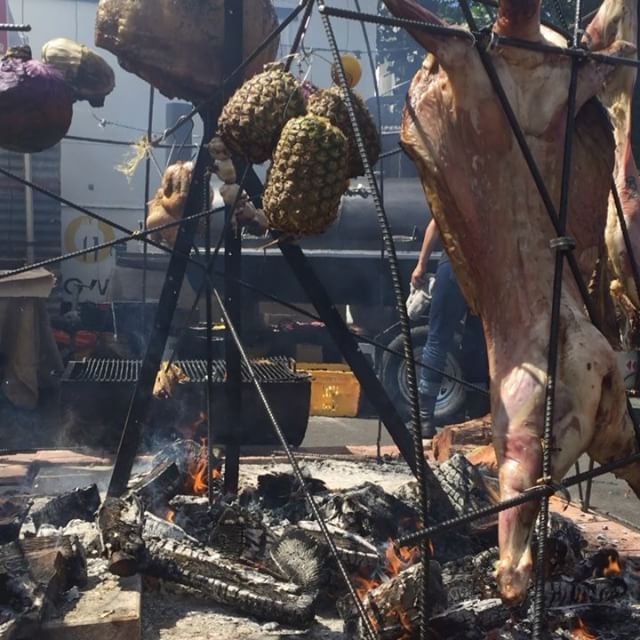I met Big Moe Cason last week. He was cool. He was big. Not as big as I’d imagined though. There he was, exhausted after a day of smoking with some of his biggest fans. He was a true professional though, put on a smile for the camera and did a video with us ahead of Meatstock.
I wanted to find out what was behind the process, given I had watched enough of of his stuff on American show BBQ Pitmasters. He’s now pretty much seen as a king of BBQ, for good reason.

Brisket, ribs and cheeks aren’t necessarily lauded for their versatility in the kitchen, but they were centre stage over Meatstock weekend, worshiped at Auckland’s inaugural festival. I decided to join in the ceremonies, as a judge. I was super-excited about the prospect when I signed up. I love smoked meats. What does it really take to decide who, out of 36 enthusiastic teams of pitmasters, is best?

Spread over two days, I was one of about 40 judges to taste each category of meat, sampling the teams’ wares and grading them from one to 10 in three categories.
Saturday started with a seminar, where we were taken through the process by our head judge, the general manager of the Australasian Barbecue Association, Adam Roberts. After that, we were accredited by the ABA, as official meat judges.
There are some quirks, but its all logical and straight-forward. Be impartial and don’t fraternise with the competitors. Plus, no booze while judging.
The categories for judging are presentation, texture and taste. Each category’s weighted too, so taste is really the king at the end of the day.

They have a programme specially created to collate all the scores, they’ve considered just about every variable under the sun. The organisers have done plenty of these competitions in Australia, so that didn’t come as too much of a surprise.
The general feeling at Meatstock was one of excitement. It wasn’t a massive piss fest, but it was a massive cross-section of New Zealand coming together for one common love. No matter whether it was apparently testosterone-fuelled, or if offended vegans, it was a good thing. There were men, women and children there, they were all excited about food and cooking, and that’s a wonderful thing. At a time when cooking is seen as a nuissance, if people are willing to spend 8-12 hours cooking on a weekend, well that’s a step in the right direction.

What I saw when I got to my table for judging was what I think was a Brit, American, Australian, and two Kiwis. Two were older women. They knew their stuff, I’d argue that they were more critical than the men. It was awesome, everyone was friendly and there for the same reason: good food. So, with that established, and everyone introduced, we kicked off with chicken and pork ribs. We were all eager to get in to the swing of things. Six judges to a table, we could try up to six team’s efforts per category, so we got about five each.
The chicken was tender, smokey and generally sweet, with both southern American styles on show and the odd piece with Asian flavours. The tricky part is perfecting the skin. Then the pork ribs came along, both dry and wet, which were slightly disappointing. I still cleaned the bones.


One of my fellow judges remarked about being a fussy eater, or the fact he wasn’t one. But when you’re in that arena, it’s easy to get into it, and be critical – but not unfair – about the barbecue. In an event like this, where these teams were spending thousands of dollars and days of their lives to compete, it’s important to be fair.
The next day started with lamb. With two black coffees and nothing else in my system, I couldn’t wait for the 10.30am start. Lamb was a favourite category, which shouldn’t come as too much of a surprise given we’re all lamb-loving Kiwis. To see lamb come in various forms, rather than a roast or chops, was nice. There were a couple of duds, but the general level was high. What followed was a general pork category, where we were treated to pulled pork and tenderloin in all different styles, and eventually beef, where we sampled brisket and short ribs.

It’s heartening to see people enthusiastic about their food, as well as proud. If anyone went to this event, it would be obvious this isn’t just a trend, this type of barbecue is here to stay and it’s time to ditch the gas, mate.
After a good couple of days of non-stop cooking and fastidious monitoring of their meats, the winners were announced.
The veteran visitors, from Australia, Country Pit Boys ended up taking the overall gong, however there were plenty of Kiwi teams in the mix.
Anyone getting in a huff about New Zealand teams not getting their fair share of the medals, consider the fact this is the first ever ABA accredited competition. Many, if not all, would have never cooked for more than their family and friends, let alone people who’re critiquing their meat strongly.

If we’re to actually have barbecue that’s worth eating, we’re going to need to learn. We’re lucky that these Australian teams jumped the ditch, because the amount of knowledge they will have imparted on our pitmaster friends is huge. Keep in mind that a couple of our boys did win, they showed they were really good and had the makings of those who’re at the top of the Australian BBQ circuit. If we’re to get better, to have teams that’re really doing good BBQ, we need to lose a couple of times. We can’t expect to get onto the pit and be doing things at All Blacks level.



It’s my dream to be a judge at a BBQ festival. I’m serious!
LikeLike
It’s pretty damn amazing!
LikeLiked by 1 person